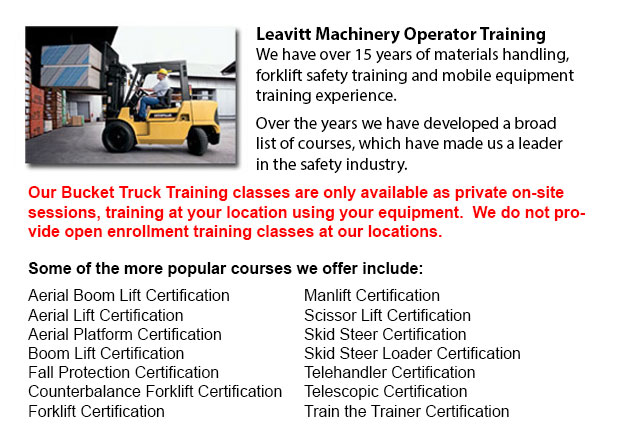
Bucket Truck Training Hamilton - The Vehicle-Mounted Aerial Work Platform or also called bucket truck training program is intended to lessen the possibility of personal injury and incident when working in close proximity or with bucket trucks by efficiently training qualified operators. An aerial lift device refers to whichever vehicle-mounted device, articulating or telescoping, or both, that is utilized to position workers to reach spots which would otherwise be not accessible. Aerial lift devices are made use of in order to elevate workers to above-ground work locations.
The program aims to provide operators with the knowledge, skills, abilities, and training materials needed to be able to efficiently and safely operate vehicle-mounted aerial work platforms.
The program has two parts: a hands-on session and a classroom training session. To become certified, participants have to be successful in both components. A full-size certificate and a wallet-size certificate would be issued upon finishing the program.
Types of lifts consist of articulating boom platforms, extensible boom platforms, vertical towers, aerial ladders and aerial ladder trucks and any combination of these devices. Aerial lift devices are normally constructed with wood, metal, fiberglass, reinforced plastic or other materials.
Definitions
Articulating boom platform: many hinged boom parts.
Extensible boom platform: has a telescopic or extensible boom.
Platform: the component of an aerial device that is designed to carry employees.
Mobile unit: a combination of aerial devices, like for example its vehicle and related equipment.
Employers have the responsibility to make certain their employee get right training prior to operating aerial devices. Workers should make sure they also obtain the needed training and that they do not operate lift devices if they are not authorized to do so. Workers must ensure that they wear the proper protective equipment if working from the platform.
Course content consists of operating the vehicle-mounted aerial work platform, safe operating practices, pre-shift inspections, lifting capacity, use of emergency controls, and administering theory and practical tests. Operators will know legal requirements under the local and federal regulations.
-
Crane Training School Hamilton
Crane Training School Hamilton - We provide industry relevant programs in our crane training school. The course would provide our trainees with learning outcomes matching the current industry demands. Our small class sizes combine theory and hand-on... More -
Crane Ticket Hamilton
Crane Ticket Hamilton - The new kind of a crane can be either complex or simple, and cranes differ based on their application. Mobile cranes, for example are quite simple. A telescopic boom or steel truss mounts its movable platform. A system of pull... More -
Aerial Platform Training Hamilton
Aerial Platform Training Hamilton - Aerial forklifts can be utilized to accomplish many different duties executed in hard to reach aerial spaces. Many of the tasks associated with this type of lift include performing routine upkeep on buildings with... More -
Forklift Safety Training Hamilton
Forklift Safety Training Hamilton - People wanting work in businesses which utilize lift trucks have to undergo a forklift safety training course before becoming a certified operator of a forklift. There are several ways to go about acquiring forklif... More -
Aerial Lift Certification Hamilton
Aerial Lift Certification Hamilton - Aerial Lift Certification is for workers who require a thorough knowledge of aerial lift safety. Maintenance workers, construction craftsmen and supervisors require this training to ensure that operators and inspe... More -
Crane Safety Training Hamilton
Crane Safety Training Hamilton - Both crane operator and their employers need to know all the possible problems associated to the use of an overhead crane. All over North America, there is legislation which provides rules for the safe inspection, mai... More -
Telehandler License Hamilton
Telehandler License Hamilton - A telehandler or telescopic handler is an equipment that is frequently utilized in industrial and agricultural applications. It has the same appearance to a lift truck and even functions in a similar manner, even if, th... More -
Heavy Equipment License Hamilton
Heavy Equipment License Hamilton - Acquiring a heavy equipment license is mandatory to operate these large industrial machines. Certification could be obtained through a vocational school or private training. The license would allow the driver to ope... More

Forklift Training Hamilton
TOLL FREE: 1-888-254-6157
Hamilton, Ontario
forklifttraininghamilton.com
Email Us
About Us


